Mark James E. (ed.). Physical Properties of Polymers Handbook
Подождите немного. Документ загружается.

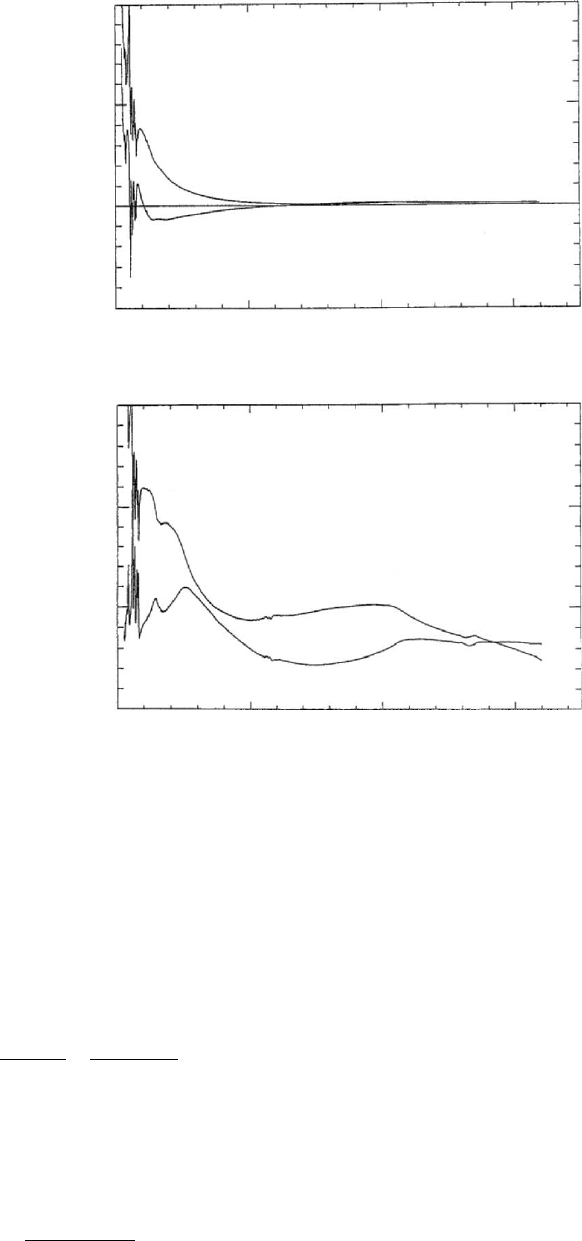
v < v
c
. For frequencies greater than v
c
, the optical con-
ductivity shows the normal Drude decrease with increasing
frequency. For three-dimensional materials, localization
corrections to the frequency dependent conductivity
[115,194,200–202] yield
s(v) ¼ s
Drude
1
C
(k
F
v
F
t)
2
þ
C(3v)
1=2
(k
F
v
F
)
2
t
3=2
, (46:10)
where C is an undetermined universal constant, k
F
is the
Fermi wavevector, y
F
is the Fermi velocity, t is the scatter-
ing time, and s
Drude
is the regular Drude conductivity given
by
s
Drude
¼
V
2
p
t
4p(1 þv
2
t
2
)
, (46:11)
where V
p
is the plasma frequency of the free electrons.
Notice that as k
F
l (i.e., k
F
y
F
t) becomes large for more
ordered higher s materials, the corrections to the Drude
formula should become negligible and the three-dimen-
sional conductor should obey the Drude formula.
The experimental optical conductivity of the doped poly-
mers evolves from localized semiconducting behavior to
metallic behavior with improved order. For (CH)
x
doped
with perchlorate (ClO
4
) [106,188,189], (Fig 46.30) or iodine
[106,162,186] with different stretch ratios, the optical con-
ductivity shows soliton features at midgap and a Drude
plasma edge which develops with stretch alignment at
200 cm
1
(0.02 eV) where the optical conductivity rises
rapidly to its dc value with a very long scattering time. The
full conduction electron plasma frequency for doped (CH)
x
is 3 eV; therefore, the plasma edge at 0.02 eV is associ-
ated with only a small fraction of the conduction electrons
[75]. Because a small fraction of the conduction electrons
appear macroscopically delocalized with a long scattering
time while the majority of conduction electrons are more
100
50
Emeraldine Salt, E
II
Emeraldine Salt, E
I
0
e
2
e
1
e
1
e
1
,
e
2
e
1
,
e
2
e
2
0
A
B
Energy (cm
−1
)
1⫻10
4
2⫻10
4
3⫻10
4
0
0
2
4
6
Ener
gy
(cm
−1
)
1⫻10
4
2⫻10
4
3⫻10
4
−50
FIGURE 46.28. Real part of the dielectric constant versus frequency for light polarized (A) parallel and (B) perpendicular to the
stretch direction in PAN doped with HCl (from Ref. [191]). The chain alignment is improved by stretching. «
1
is negative in the mid
IR for the parallel direction but not for the perpendicular direction, implying that the delocalization is much greater along the chain.
CONDUCTING POLYMERS:ELECTRICAL CONDUCTIVITY / 741
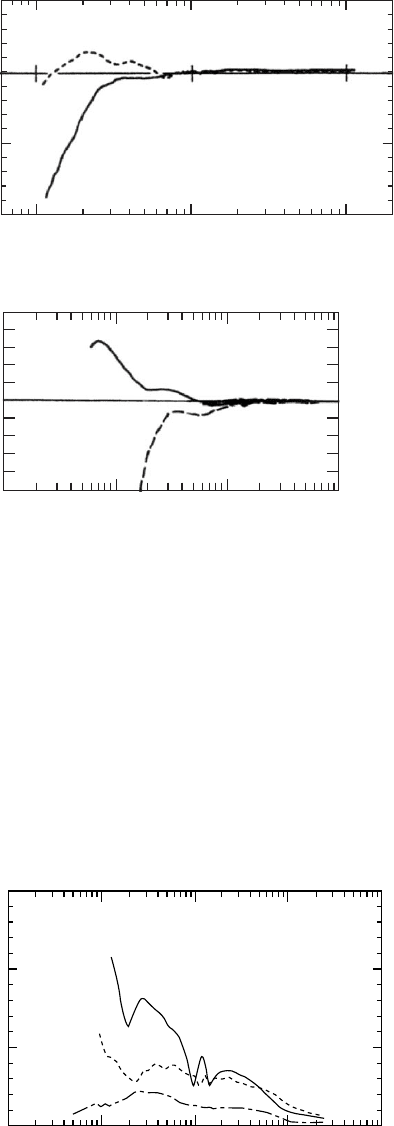
strongly localized, with a short scattering time, the localiza-
tion modified Drude model [115,194,200–202] does not
simultaneously fit well the frequency dependent dielectric
function and conductivity of highly conducting (CH)
x
.
Models which take into account the inhomogeneous dis-
order of the systems provide a better representation as they
allow for composite behavior (metallic islands which per-
colate in a semiconducting matrix).
Typical optical conductivity spectra for PAN and PPy
films are shown in Figs. 46.31 and 46.32, respectively. For
highly conducting PAN–CSA (m-cresol) [s
DC
120 S=cm]
[193], s
1
begins to increase with decreasing wavenumber at
10,000 cm
1
(1.2 eV) to values as high as 750 S/cm
at 0.1 eV and then decreases consistent with localization
behavior. However, at 0.02 eV, s
1
begins to increase,
qualitatively similar to the behavior of doped (CH)
x
though
the increase in the far IR is not as rapid as for doped (CH)
x
as
the dc conductivity is much lower for this PAN–CSA ma-
terial. This type of frequency behavior for s
1
is qualitatively
similar to the composite behavior of metallic particles (is-
lands) in a semiconducting matrix after percolation of the
metallic particles [203]. PPy(PF
6
) [74,198] [s
DC
300
S=cm] has similar behavior, though s begins to increase
with decreasing wavenumber at a higher all-conduction-
electron ‘‘plasma edge’’ of 17,000 cm
1
(2.1 eV).
In contrast to this behavior, s for other doped PAN and
PPy materials show more localized behavior. For example,
the optical conductivity of PAN–CSA cast from a solution
of chloroform and exposed to m-cresol [s
DC
¼ 20 S=cm]
[192], PAN–HCL (‘‘intermediate cross linked (crystallin-
ity)’’ IXL) [s
DC
10 S=cm] [193], PPy(TsO) [74.198]
[s
DC
100 S=cm], and PPy(S-PHE) [s
DC
10 S=cm]
[46,192] have maxima (in addition to phonon features) at
higher energies in the IR than more highly conducting PAN
and PPy. In the far IR, s decreases with decreasing fre-
quency more rapidly for these samples with increased dis-
order as expected for localized electrons. Similar behavior
has been reported for perchlorate (ClO
4
) doped PPy
[166,187] and PF
6
doped poly(3-methylthiophene) [190]
(Fig. 46.33). For the lower conductivity doped polymers,
the localization modified Drude model [115,200–202] has
the same frequency dependence as the experimental spectra.
The low frequency conductivity peak shifts to lower energy
with increasing dc conductivity in both PAN [197]
(Fig. 46.31) and PPy [74] (Fig. 46.32) and likely results
from the decrease of the critical frequency v
c
as the samples
become more ordered. For the low conductivity PAN sam-
ples, most of the oscillator strength is shifted [146] into a
peak at 1.5 eV associated [54,146] with localized polar-
ons. Thus with decreasing order the oscillator strength shifts
to higher wavenumber and thus higher binding energies.
Qualitatively, the PAN and PPy materials with
s
DC
< 200 S=cm show the behavior expected for both the
good conductor/poor conductor composites as well as for
the three-dimensional localization modified Drude model.
The optical conductivity of highly conducting stretched
WAVE NUMBER / cm
−1
10
1
d
1
−1000
0
d
1000
10
2
10
3
10
4
c
WAVE NUMBER / cm
−1
real part of dielectric function
−100
−50
0
a
50
10
2
10
3
10
4
b
FIGURE 46.29. Top: real part of the dielectric constant ver-
sus frequency for light polarized perpendicular to the stretch
direction in (CH)
x
doped with ClO
4
(from Ref. [188]). For
sample (b), the chain alignment is improved over the sample
(a) by stretching. «
1
is negative at low frequencies indicating a
three-dimensional metallic state. Bottom: real part of the di-
electric constant vs. frequency for light polarized parallel to
the stretch direction (from Ref. [187]). Samples (c) and (d) are
both doped to the same level with iodine, but sample (c) was
stretched before doping, resulting in greater ordering and a
more metallic response.
10
1
0
5000
(a)
(b)
(c)
WAVENUMBER / cm
-1
CONDUCTIVITY .Scm
-1
10000
15000
10
2
10
3
10
4
10
5
FIGURE 46.30. Optical conductivity versus frequency for
(CH)
x
of different stretched ratios (a: stretched 8;b:
stretched 4; c: unstretched) doped with perchlorate (ClO
4
)
(from Ref. [188]). There is a growth of a free carrier band
(Drude response) around 200 cm
1
with increased stretch
ratio.
742 / CHAPTER 46
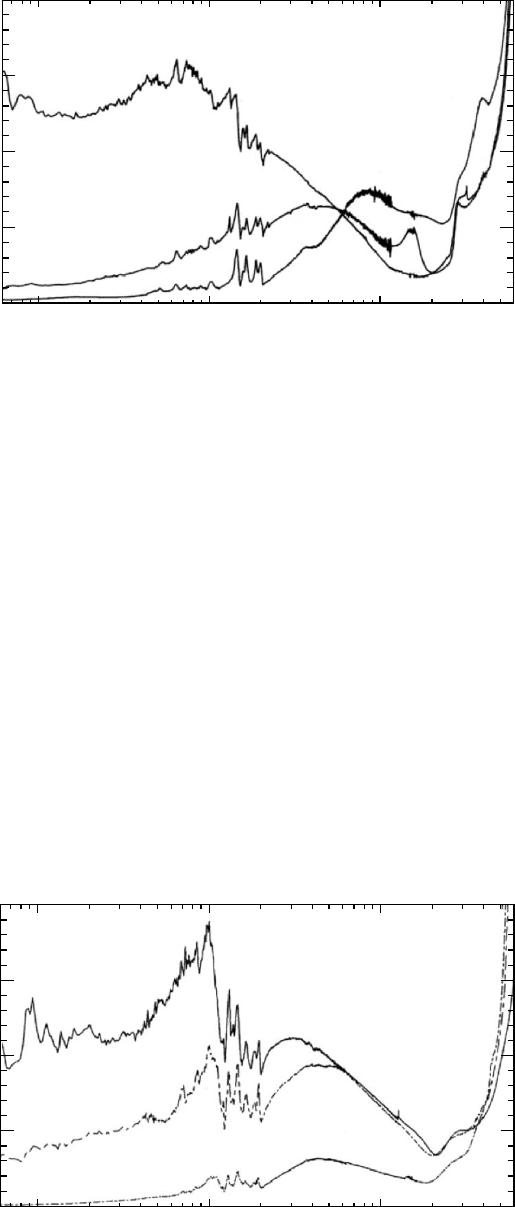
polyacetylene and doped PAN and PPy with s
DC
>
200 S=cm show Drude behavior for a small fraction of the
conduction electrons which essentially percolate through
the film while the remaining conduction electrons are
more localized.
46.9 ULTIMATE CONDUCTIVITY
46.9.1 Drude Model Analysis
The intrinsic conductivity of conducting polymers is of
interest for fundamental science and future materials appli-
cations. Though the materials currently have s
DC
less than
common metals, the conducting polymers are not fully
crystalline. Past progress suggests that as the synthesis,
doping routes, and processing are improved, further
advances in materials properties can be expected. Esti-
mates of the ultimate conductivity [122] of the quasi-one-
dimensional polymer systems assuming the primary
momentum relaxations are from 2k
F
phonons which have
modest population at room temperature suggests the ultim-
ate conductivity for (CH)
x
is 2 10
6
S=cm (compared to
5:5 10
5
S=cm for copper).
From the experimental data which exist for current sys-
tems, estimates of the intrinsic conductivity also can be
made [197]. The intrinsic Drude nature of metallic carriers
has been identified using both microwave and optical tech-
niques. Both of these techniques have identified the pres-
ence of a group of carriers which demonstrate Drude
behavior with a long scattering time (t 10
11
s). The
Drude conductivity for traditional metals is given by
0.01
0
A
B
C
250
500
750
1000
0.10
Enegy (eV)
Optical Conuctivity (S/cm)
1.00
FIGURE 46.31. Room temperature optical conductivity vs. frequency for PAN–CSA(m-cresol) (A) PAN–CSA (chloroform/m-
cresol) (B), and PAN–HCl IXL (C) (from Refs. [192, 193, and 224]).
Energy (eV)
OPtical Conductivity (S/cm)
0.01
0
300
B
A
C
600
900
1200
0.10 1.0
FIGURE 46.32. Room temperature optical conductivity versus frequency for PPy(PF
6
) (A), PPy(TsO) (B), and PPy(S-PHE) (C)
(from Refs. [74, 192, and 224]).
CONDUCTING POLYMERS:ELECTRICAL CONDUCTIVITY / 743
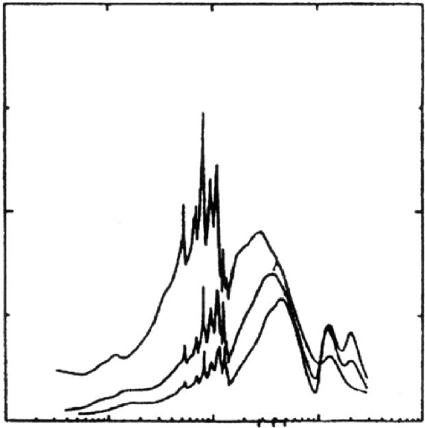
s ¼ ne
2
t=m
. In the present systems, only a small fraction
(0.1%) of the conduction electrons show this Drude be-
havior. If all of the conduction electrons (determined by
doping percentage) have a scattering time equivalent to
t 10
11
s, then s
ultimate
10
7
S=cm.
46.9.2 Resonance Quantum Transport in Doped
Conducting Polymers
Metallic doped polymers (polyaniline and polypyrrole)
have an electromagnetic response that, when analyzed
within the standard theory of metals, is provided by an
extremely small fraction of the total number of available
electrons 0.1% (in contrast to 100% for common
metals) but with anomalous long scattering time
t $ 10
13
s (more then 100 times longer than for common
metals). Prigodin and Epstein have shown [220] that a
network of metallic grains (polymer’s crystalline domains)
connected by resonance quantum tunneling through local-
ized states in surrounding disordered medium produces this
behavior. The small fraction of electrons is assigned to the
low density of resonance states and the long scattering time
is related to the narrow width of energy levels in resonance.
This differs from the general consensus [221–224] that the
difference in doped conducting polymers between metal
and insulator at low temperatures is caused by disorder
driven localization of the conduction electrons (Anderson
insulator–metal transition (IMT)) [153].
Figure 46.34 reviews the two conventional single particle
transport mechanisms. For band transport (Drude theory)
electrons behave as ‘‘free particles’’. They are accelerated
by the applied electric field and loose their momentum
through scattering by impurities and phonons. As a result,
an electron’s motion may be described as quantum diffu-
sion. At low temperature the phonon scattering becomes
weak and the conductivity increases with decreasing tem-
perature to its residual value. For hopping the zero tempera-
ture electrical conductivity is zero because the charge
carriers are localized. At finite temperatures electrons hop
from one localized state to another by absorbing or emitting
phonons. In contrast to band transport, hopping conductivity
increases with temperature because of increased availability
of phonons (see Fig. 46.34).
The dielectric constant « can be used to identify the
mechanism of charge transport [222,224]. For band trans-
port, « is negative because of inertia of ‘‘free electrons’’; for
hopping « is positive and proportional to the square of the
size of the localized state. Hopping often is expected to be
the basic mechanism of transport for polymers because of
their irregular structure and because even weak disorder
localizes electrons in single isolated chains. This type of
conductivity is observed in the dielectric polymers (doped
polymers that become insulators at low temperatures) and
their behavior qualitatively follows the above dependencies.
However, the behavior of metallic polymers can be under-
stood within neither the above hopping model nor the model
of conventional metal with band electrons. The metallic
conductivity of doped polymers decreases with decreasing
temperature and a finite residual conductivity is within a
decade of the room temperature value.
Though the decrease of the dc conductivity for metallic
polymers with decreasing temperature can be accounted for
within the band model by effects of localization caused by
disorder, the experimental optical and low frequency con-
ductivity and dielectric constant in the metallic state of
doped polymers in principle cannot be accounted for by
band models with homogeneous disorder. Experiments
[221–224] show that the high frequency ($ 0.1 eV) con-
ductivity and dielectric constant generally follows a Drude
law with the number of electrons 10
21
cm
3
correspond-
ing to the total density of conduction electrons and conven-
tional scattering time 10
15
s in both the metallic and
dielectric phases (Figs. 46.26–46.28). At decreasing fre-
quency the polymers in the dielectric phase progressively
display insulator properties and « becomes positive for
frequency # 0.1 eV signaling that charge carriers are now
localized. Microwave frequency ( 6.6 GHz) « experiments
[222] yield localization lengths 5 nm, depending on
sample.
A surprising and remarkable feature of the metallic phase
in polymers is that «(v) is similar to that of dielectric
samples in magnitude and sign with decreasing frequency,
also changing sign from negative to positive at approxi-
mately the same frequency 0.1 eV. However, for metallic
WAVE NUMBER / cm
−1
10
1
0
1
1.0
CONDUCTIVITY / 10
3
Scm
−
1
2.0
10
2
10
3
10
4
10
5
2
3
FIGURE 46.33. Optical conductivity versus frequency for
poly-(methylthiophene) (PMT) doped with PF
6
as a function
of doping level (from Ref. [190]). The spectra are for different
doping levels [with (1) being highest and (3) the lowest doping
level].
744 / CHAPTER 46
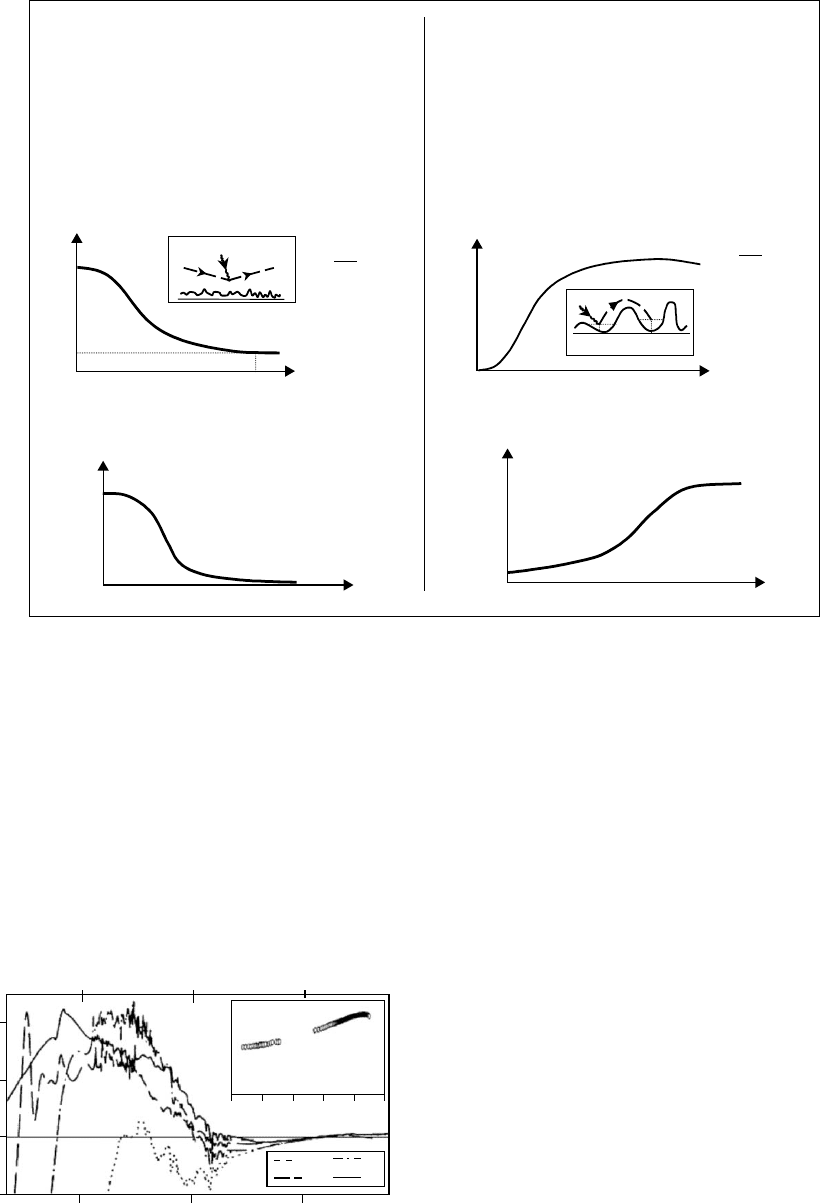
samples « changes again to negative at yet lower frequencies
# 0.01 eV indicating that ‘‘free electronic’’ motion is pre-
sent, Fig. 46.35. The parameters of this low frequency
coherent phase are quite anomalous. From the Drude
model, the relaxation time is very long $10
13
s; also, the
new plasma frequency below which « is again negative is
very small 0.01 eV [3,5]. This second zero crossing of the
dielectric constant at low frequency and the conclusion
about a long relaxation time and a small plasma frequency
were confirmed with radio frequency conductivity studies
[225].
These experimental data contrast with the Anderson IMT
[153] in which electronic behavior is controlled by homo-
geneous disorder. In the dielectric phase electrons are bound
by fluctuations of the random potential. On the metallic side
of the transition, free carriers have short scattering times.
In the metallic phase near the transition, « is positive
because the disorder causes dynamic polarization due to
slowing diffusion by localization effects. When approaching
the IMT the localization effects increase and « diverges
(‘‘dielectric catastrophe’’ [200]).
The small plasma frequency and very long t of the
metallic state in doped polymers can be explained [222,
224,225] assuming that the conductivity is provided by a
small fraction 0.1% of the total carriers with long scatter-
ing time > 10
13
s. However, it is difficult to reconcile this
conclusion with the behavior for high frequencies which
supports that the scattering time is usual 10
15
s and all
available electrons participate in conduction. To account for
these anomalies the possible presence of a collective mode,
as in a charge density wave conductor, or superconductor,
was suggested [199].
Prigodin and Epstein proposed [220] that in highly con-
ducting polymers there is a new mechanism of charge
transport, resonance quantum tunneling among metallic
domains. These materials are strongly inhomogeneous
[18,62,127,133] with ‘‘crystalline’’ regions within which
polymer chains are well ordered (Fig. 46.36). Electrons are
Band Transport Hopping Transport
2. Polarization is out-of-phase with an applied
electric field due to electron inertia:
l is the mean free path
e(w ~0) = −e
2
N(e
F
) l
2
<0 e(w~0) = −e
2
N(e
F
) x
2
<0
2. Polarization is in-phase with an applied electric
field because the electron is bound within x:
x is the localization radius
3. Phonons resist electron’s motion: 3. Phonons initiate electron’s hops:
4. Absorption increases with frequency of an
applied field due to polarization losses by clusters:
4. Absorption decreases with frequency of an
applied field because of less collisions :
1. Extended states: s(T=0) = s
0
1. Localized states: s(T=0) = 0
Re s(w)
w
Re s(w)
w
ds
dT
< 0;
s
RT
≥ s
mm
300K
s
0
s
RT
s(T)
T
> 0;
ds
dT
s
RT
≥ s
mm
300K
r
1
r
2
s
RT
s(T)
T
FIGURE 46.34. Comparison of band and hopping mechanisms of transport (after Ref. [220]).
0.1
1
0.01
–20
0
C
B
A
A
0.01
10
50
s (S/cm)
300
1
100
D
A
T (K)
C
D
B
20
40
e(w)
Energy (eV)
FIGURE 46.35. «(v) for camphor sulfonic acid doped poly-
aniline samples with room conductivities in the order of
s
A
> s
B
> s
C
> s
D
(Inset, s
DC
(T)). (after Ref. [222]).
CONDUCTING POLYMERS:ELECTRICAL CONDUCTIVITY / 745
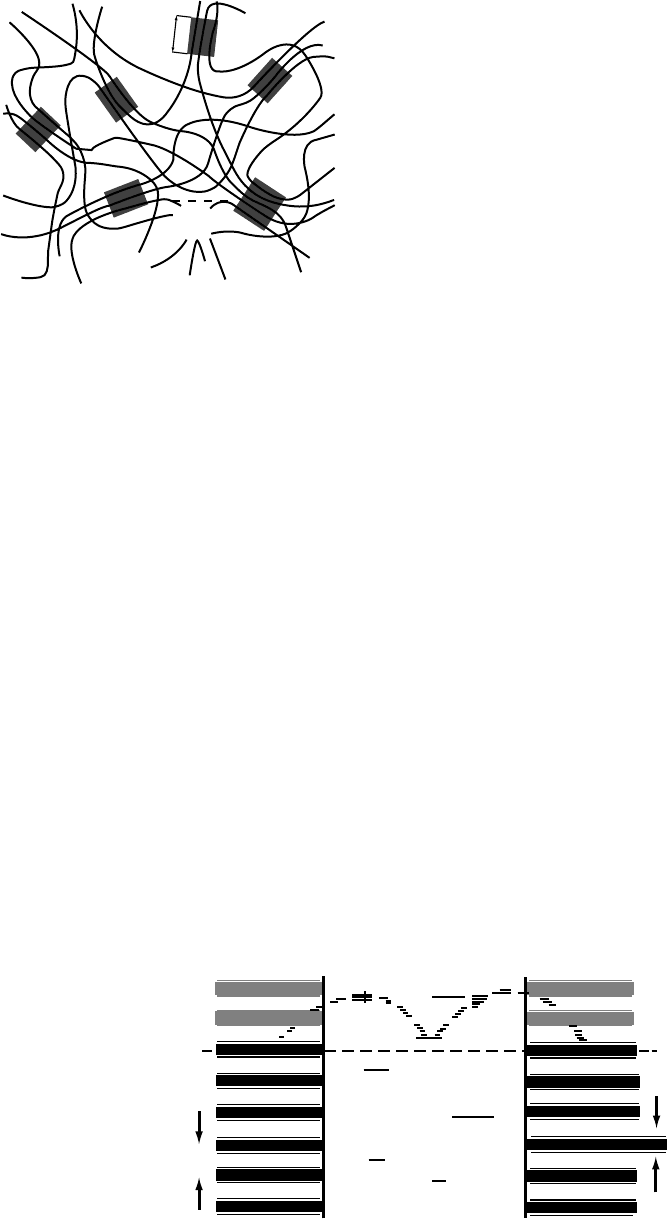
considered to be three-dimensionally delocalized over
grains due to good overlap between chains within the grains.
At least, when the IMT is approached, an electron’s
delocalization first occurs inside these regions. Outside the
crystalline regions the chain order is poor and the electronic
wave functions are strongly localized within single chains.
Therefore, the crystalline domains can be considered as
nanoscale metallic dots embedded in a disordered poorly
conducting medium. The metallic grains remain always
spatially separated by disordered regions, and, therefore,
direct tunneling between grains is exponentially suppressed.
The intergrain tunneling is possible through intermediate
localized states in the disordered portion with strong contri-
bution from resonance states whose energy is close to the
Fermi level (Fig. 46.37). The dynamics of resonance tun-
neling can account for the frequency-dependent anomalies
in the conductivity and dielectric constant of the metallic
phase of these doped polymers. Reference [220] provides a
detailed description and quantitative analysis of this model.
Within the Prigodin and Epstein model each grain is
coupled to other grains by 2N
?
independent chains. For
simplicity one may assume that the two nearest grains are
electrically connected by N
?
=z chains, where z is the
number of nearest neighboring grains. In the metallic
phase the intergrain coupling leads to broadening of quant-
ized levels in the grains, dE ¼ 2N
?
gDE, where g is the
transmission coefficient between grains through a single
chain. The IMT occurs when dE DE and the critical
chain-link coupling g
c
satisfies
2N
?
g
c
¼ 1: (46:12)
For PAN(HCl) and similar PAN(CSA) this yields
g
c
10
2
.
If g < g
c
the system is a dielectric and the behavior (46.4)
is retained for all vt
T
1. However, on the metallic side
(g > g
c
) electrons are delocalized and their low-frequency
motion is a random walk among the grains. Introducing the
mean transition rate, W, for hopping between the grains and
the mean distance between the centers of neighboring
grains, R(b (L
k
=R)
3
), the corresponding diffusion coeffi-
cient D
3
and the macroscopic conductivity are
D
3
¼ R
2
W, s(v 0) ¼ be
2
N(«
F
)D
3
: (46:13)
When approaching the IMT from the metallic side W tends
to 0 as [12]: W ¼ (DE=(2z) ) exp [ 2p(g
c
=(g g
c
))
1=2
]. In
the metallic phase the hopping frequency W is related to the
above model parameters as
W ¼ dE=(2z) ¼ (N
?
=z)gDE, (46:14)
and the whole system can be represented as a network of
random conductors. The nodes represent the grains where
randomization of electronic motion happens. Further details
of analysis and its application to specific polymers are in
Ref. [220].
A principal difference between direct and resonance tun-
neling is the time for tunneling. Direct tunneling that occurs
in a conventional granular metal is an almost instantaneous
process, i.e., its characteristic time is the scattering time t.
Resonance tunneling that is anticipated to be in the metallic
polymers shows a delay determined by the level width g.
R
L
II
FIGURE 46.36. Schematic view of the structure of polyani-
line and polypyrrole. The lines represent polymer chains. The
dashed squares represent regions where polymer chains
have crystalline order.
Dot 2
Dot 1
E
F
E
F
δ
E
∆E
FIGURE 46.37. Schematic illustration of the electrical coupling of the metallic grains being provided by resonance tunneling of
between the quantized states of the metallic grains through localized states in the amorphous region.
746 / CHAPTER 46
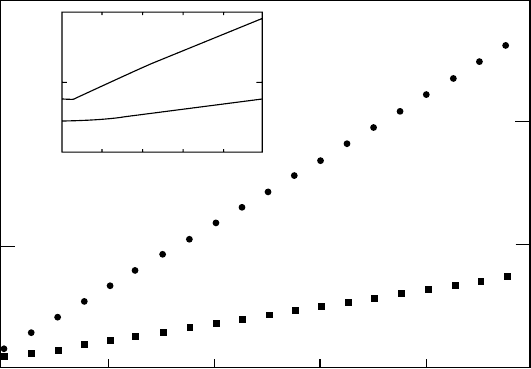
The temperature dependence of the dc conductivity in the
metallic phase follows from that expected for resonant tun-
neling through the strongly localized states in the amorph-
ous regions of the metallic polymer. With increasing
temperature phonons increase the localization length of the
states in the disordered regions thereby increasing the res-
onant transmission rate between grains and increasing the
conductivity. As a result the low-frequency part of electro-
magnetic response is shifted with increasing temperature
to a range of higher frequencies as it experimentally is
observed [222].
46.10 APPLICATIONS
Intrinsically conducting polymers (ICPs) also are of inter-
est for a wide range of applications [204]. The ICPs have
been proposed for use as conducting wires, in batteries
[205], as electromagnetic interference (EMI) shielding ma-
terials [206–209], joining (welding) of plastic materials
[210], light emitting diodes (LEDs) [211], sensors [212],
anticorrosive coatings [213], etc.
In LED studies, doped polyaniline and its blends have
been used for the hole injecting layer [214], and undoped
poly(p-phenylene vinylene) and other materials have been
utilized for the light emitting layer [211]. More recently, a
symmetrically configured alternating voltage light emitting
(SCALE) device based on electronic polymers has been
demonstrated [215,225,226,227]. The advantages of ICPs
for light emitting devices include flexibility, mechanical
strength, and relatively easy control of the color of light
emission. Transparent conducting polymers may be incorp-
orated as electrodes in efficient LEDs [216].
The use of plastics and their composites is rapidly in-
creasing in numerous areas. However, the final assembly of
products is often limited by the capability of existing joining
techniques. The ability of ICPs, especially polyanilines, to
absorb electromagnetic radiation and convert it into heat
introduces another application in the welding of thermoplas-
tics and thermosets [210].
With the rapid advances and broad implementation of
computer and telecommunication technologies there is an
increased need to shield EMI, especially in the radio and
microwave frequency ranges. Intrinsically conducting poly-
mers are promising materials for shielding of EMI because
of their relatively high conductivity and dielectric constant
and the ease of control of their conductivity and dielectric
constant through chemical processing [207]. Also, they are
relatively lightweight compared to standard metals, flexible,
and do not corrode as common metals. The microwave
conductivity and dielectric constant of polyanilines are con-
trollable through chemical processing (e.g., stretch ratio,
molecular weight, doping level, counter ion, solvent, etc.).
Figure 46.38 compares the total shielding efficiency of
PAN–CSA (m-cresol) materials with that of copper on the
base of mass/area, while Fig. 46.39 compares the shielding
efficiency of several different conducting polymer systems.
The ability to disperse conducting polymers into insulat-
ing hosts such as poly(3-octylthiophene) in polyethylene
[217] and PAN–CSA in polymethylmethacrylate [218], or
nylon [219], and achieve percolation at less than 1%,
increases opportunities for applications.
Active electronic devices fabricated from semiconducting
organic and polymer materials have become of increasing
interest. In particularly, regioregular poly(3-hexylthio-
phene) (P3-HT) has been of interest because its relative
0
0246810
20
0
500
100
0
500
1000
SE
T
(DB)
SE
T
(DB)
10000
40
mass / area (mg/cm
2
)
mass / area (mg/cm
2
)
polyaniline
polyaniline
Cu
Cu
60 80 100
FIGURE 46.38. Comparison of total shielding efficiency (SE
T
) of PAN–CSA (m-cresol) samples and copper (Cu) as a function of
mass/area. Inset: magnification below 10 mg=cm
2
(from Ref. [207]).
CONDUCTING POLYMERS:ELECTRICAL CONDUCTIVITY / 747
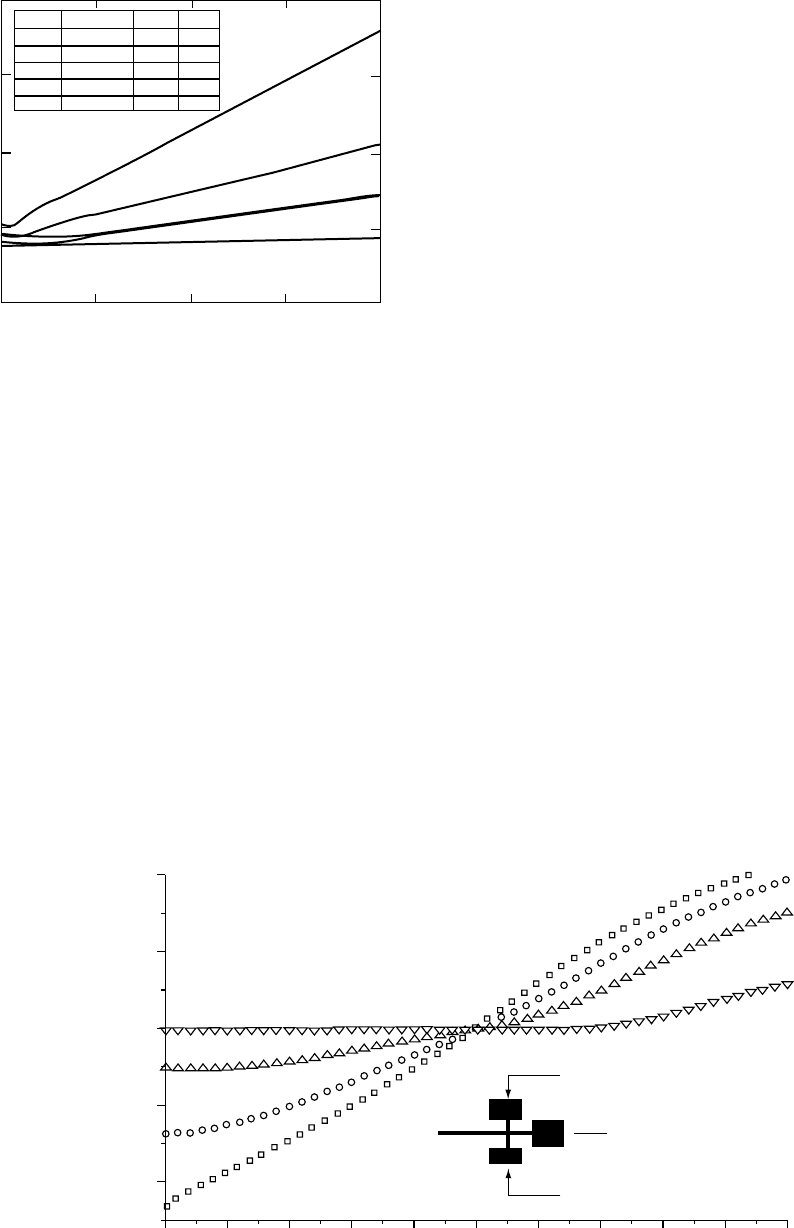
structural order leads to a high mobility, in the range of
0:2cm
2
=(Vs) [228–231].
Recently a new interesting phenomenon, an electric field
effect, was reported for the doped highly conducting poly-
mers [232–235]. Figure 46.40 shows I–V characteristics of
such a transistor [236] in which conducting polymer PED-
OT:PSS [poly(ethylene dioxythiophene): poly(styrenesulfo-
nic acid)] with s
RT
30 S=cm is used as active electronic
element and PVP [poly(vinylphenol)] is used as a dielectric
separating the gate and source–drain channel. As it is shown
on Fig. 46.40 the I
D
current decreases with gate voltage V
G
similarly to that normally observed for conventional semi-
conductors. The ratio I
ON
=I
OFF
reaches up to 10
4
in some
devices [232–236].
Epstein et al. suggest [232,235] that the observed field
effect in conducting polymers based ‘‘transistor’’ is closely
related to the mesoscopic inhomogeneity of conducting poly-
mers. They emphasize that the field effect cannot be observed
if the conducting polymer is a conventional conductor. For
conducting polymers with conductivity of 30 S/cm, the
screening radius for an electric field produced by the FET
gate electrode is expected to be less then 2 nm [232].
Epstein et al. propose that the field effect in conducting
polymers is due to the ionic component of their charge con-
ductivity. The inhomogeneous structure leaves enough free
space for mobile ions. The ions inside the polymers produce
the additional screening of the external field, but the crucial
feature of ions is the ability of ions to migrate between the
conducting polymer film and external dielectric layer inter-
face. As a result the concentration of ions inside of the poly-
mer is controlled by the gate potential. Due to
electroneutrality the internal ionic density determines the
concentration of primary charge carriers in the polymer and
therefore it is anticipated that the polymer conductivity is
governed by the gate potential. The critical concentration of
ions for disrupting the conductivity along the polymer chains
within the disordered regions was estimated within the fol-
lowing simple picture. If 50% crystallinity and size grain
10 nm were assumed, then intergrain hopping includes
ten intermediate sites along the chain linking two ordered
regions. To interrupt this connection it is enough to introduce
only one ion, i.e., approximately 5% ‘‘dedoping’’ would pro-
duce an appreciable effect. Figure 46.41 schematically illus-
trates the ability of a small concentration of excess ions to
control the electrical conductivity of a doped polymers.
40 60 80
20
0
0
50
100
150
A
B
C
D
E
200
Thickness (m
m)
SE
T
(dB)
highly conducting polymers
A
sample
σ
mw
(S/cm)
4700
940
560
290
110
10
−5
ε
p
−17
−3.9
−0.70
−1.0
0.32
⏐tanδ⏐
0.77
0.67
2.2
0.80
0.99
B
C
D
E
FIGURE 46.39. Comparison of total shielding efficiency
(SE
T
) of highly conducting polymers versus sample thick-
ness. Sample A: stretched heavily iodine doped Tsukamoto
polyacetylene; sample B: unstretched heavily iodine doped
Tsukamoto polyacetylene; sample C: PAN–CSA (m-cresol);
sample D: PPy(PF
6
); sample E: PPy(TsO) (from Ref. [207]).
The inset shows the microwave transport parameters
s
mw
, «
t
, and tan d for each of the materials.
−5
−2.0µ
−1.0µ
0.0
1.0µ
2.0µ
−4 −4 −4 −4
01
V
D
(V)
Drain electrode (D)
Gate electrode (G)
Source electrode (S)
V
GS
=+3.0V
l
D
(A)
PEDOT:PSS(60 nm)/PVP(25 nm)/Al(40 nm)
+1.5V
+1.0V
+0.0V
2345
FIGURE 46.40. The drain–source current as the function of drain voltage of a thin PEDOT:PSS/PVP film. The insert shows the
polymer-based transistor configuration (after Park et al. [236]).
748 / CHAPTER 46
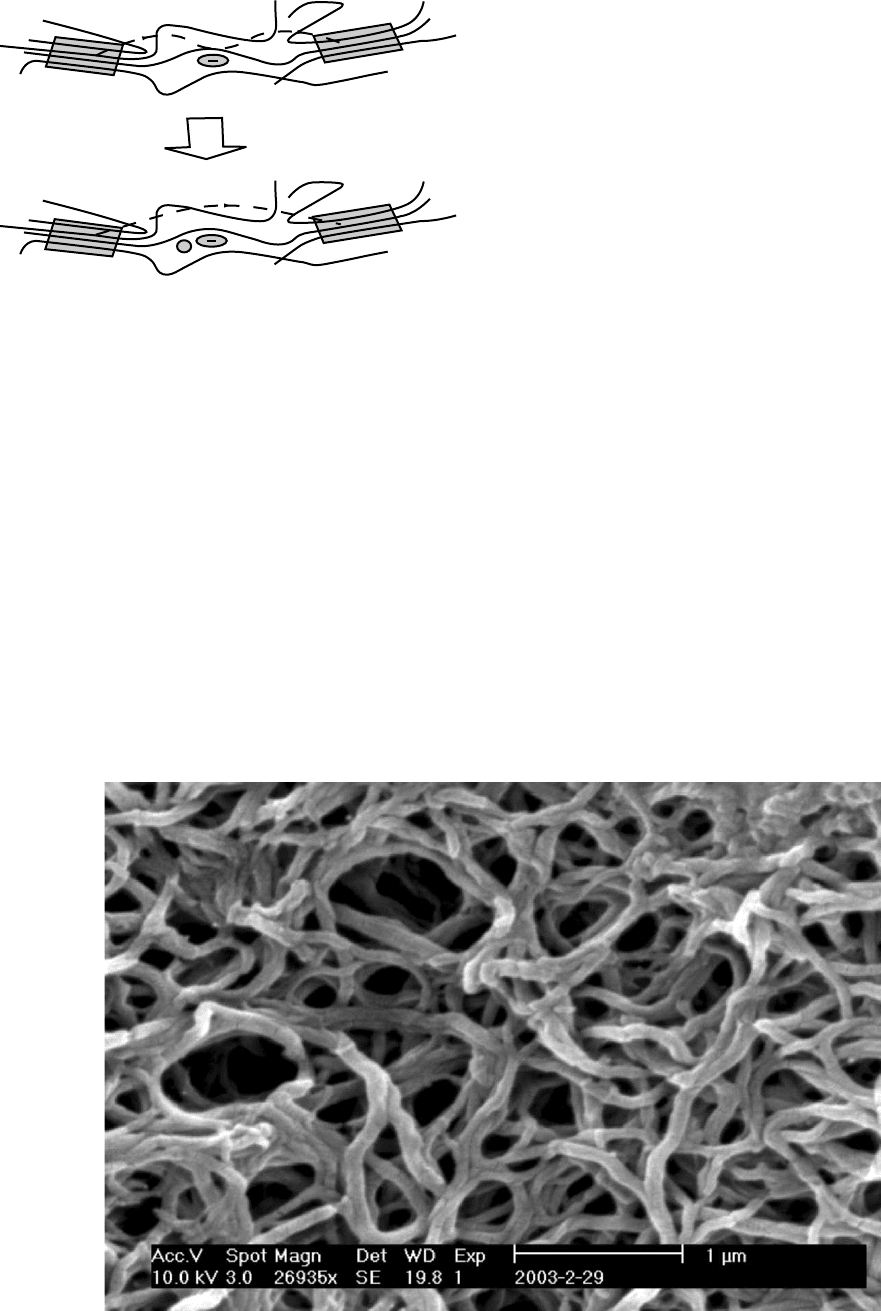
46.11 NANOSTRUCTURING OF CONDUCTING
POLYMERS
The conventional chemical polymerization of polyaniline
only produces nonfibrous or irregular shaped morphologies
[237,238]. In the past several years, a variety of chemical
methods were reported that yield polyaniline nanofibers,
such as use of hard templates [239,240], soft templates
[241], electrospinning [242], interfacial polymerization
[237], and seeding polymerization [238]. Recently, Chiou
and Epstein discovered that polyaniline nanofibers can
be directly synthesized in dilute chemical polymerization
without aid of specific templates or techniques [243]
(Fig. 46.42).
The nanofibrous structures prepared from dilute polymer-
ization have no significant change when dedoped and redoped
multiple times by base and acid solutions, respectively. The
dispersion in deionized water of nanofibers is stable for sev-
eral minutes without aggregation and precipitation [239].
Furthermore, a highly porous film of nanofibers is obtained
as the dispersion is cast and dried on the glass or silicon wafer
substrates. The UV/vis absorption patterns of polyaniline
nanofibers obtained are consistent with previously reported
results for conventionally synthesized polyaniline.
46.12 SUMMARY
The electrical transport properties of conducting poly-
mers span the behaviors associated with semiconductors
through to metals. Their properties depend critically upon
the history of chemical synthesis, processing, and resulting
structural order. Highly conducting doped polyacetylene,
doped polypyrrole, and protonated polyaniline have similar
dielectric responses, though on somewhat different scales.
For each of these systems a positive dielectric constant
is recorded at microwave frequencies for less conducting
samples. A complex ‘‘metallic Drude response,’’ involving
both an all conduction band electron response and a delo-
calized electron response, is detected for well-processed,
highly conducting samples. The ability to engineer the
electrical and dielectric properties using chemistry opens
the opportunity for a wide range of applications from elec-
trostatic dissipation to sensors and field effect transistors.
⫹
FIGURE 46.41. Schematic illustration of ionic suppression of
intergrain hopping. Compensation by cations of charge of
acceptors removes the nearby localized states on the polymer
backbone that provide for holes easy hopping of electrons
between grains. Reprinted from Ref. [235] ß (2005) with
permission from Elsevier.
FIGURE 46.42. Nanofiber network of polyaniline prepared by dilute polymerization. Reprinted from [243] ß (2005) with permission
from Wiley-VCH.
CONDUCTING POLYMERS:ELECTRICAL CONDUCTIVITY / 749
Development of nanofibers and other morphologies will
lead to new fundamental science and new opportunities for
applications.
ACKNOWLEDGMENTS
This work was supported in part by the Office of
Naval Research and National Science Foundation. The
author thanks R. Kohlman, J. Joo, Vladimir Prigodin,
Fang-Chi Hsu, June Hyoung Park, and Nan-Rong Chiou
for discussions.
GLOSSARY OF TERMS
Anderson Localization: spatial localization of electronic
wavefunctions due to randomness of the electronic potential
which causes a metal–insulator transition in sufficiently
disordered materials.
Antisoliton: solitons are present in materials with two
degenerate phases A and B. If a soliton is a kink between
A and B phase, then an antisoliton is a kink between B and A
phase.
Bipolaron: a bipolaron is similar to a polaron except that
it is doubly charged, spinless, and both of its energy states in
the band gap are totally filled or empty.
Bloch Waves: delocalized electronic wavefunctions
which have the form c
k
(
~
rr) ¼ u
k
(
~
rr) exp (i
~
kk
~
rr), where u
k
(
~
rr)
is a function with the periodicity of the lattice unit cell and
exp (i
~
kk
~
rr) is a wave of wavelength l ¼ 2p=k.
Commensurate Charge Density Wave: a static modulation
of the charge density in the system with a periodicity
equal to a rational number multiplied by the underlying
periodicity of the lattice. Due to the charge density wave, a
gap is opened at the Fermi level which lowers the total energy
of the system.
Crosslinked Polymers: polymers with greater interaction
between chains either through regions of greater crystallin-
ity (physical crosslinks between the polymer chains), or
through chemical bonding between chains.
Crystalline Coherence Length: a length which character-
izes the spatial correlations for the polymer chain, indicating
the length over which the local order randomizes. This
length is determined from the width of x-ray scattering
peaks from the Scherrer formula.
Curie Susceptibility: Paramagnetic susceptibility due to
uncoupled spins free to align in a magnetic field and subject
only to thermal fluctuations. The Curie susceptibility is
given by w
Curie
¼ C=T, where C is the Curie constant
(0.375 emu K/mol) and T is the temperature.
Degenerate Ground State: for a degenerate ground state,
the conjugation path is such that reversal of the single and
double bonds results in a phase of the system with an
equivalent energy.
Doping: a process whereby charges are removed or added
to the polymer chain, altering the electronic structure and
response.
Dru
¨
de Model: this model of the electrons in a conductor
treats the electrons as free, subject only to dissipative, iner-
tial, and electromagnetic forces. In this model, the conduct-
ivity s (v) and the dielectric function «(v) are given as
s(v ) ¼ (V
2
p
t=4p)=(1 ivt) and «(v) ¼ «
B
V
2
p
=(v(v þ
i=t) ), where V
p
is the plasma frequency and t is the mean
scattering for transport.
Electron–Electron Interactions: a broad term referring
to the electromagnetic interaction between electrons
as well as some of the effects of the Pauli exclusion prin-
ciple.
Exciton: an electron–hole pair bound by Coulombic
forces capable of transferring energy but not charge because
it is electrically neutral.
Hole: a vacant orbital in an energy band which acts as a
positive charge in an applied electric or magnetic field.
Hopping Transport: a form of charge transport which
involves electron motion from one spatially localized state
to another accompanied by the absorption or emission of a
phonon.
Incommensurate Charge Density Wave: similar to a com-
mensurate charge density wave except that the periodicity of
the charge density modulation does not equal a rational
number multiplied by the periodicity of the underlying
lattice.
Inhomogeneous Disorder: Structural configuration for a
polymer solid which consists of a mixture of ordered (crys-
talline) and disordered regions of the polymer.
Kramers–Kronig Analysis: a set of mathematical relations
due to causality which relate the real (dispersive) and im-
aginary (absorptive) parts of a physical quantity. These
relations can be used to determine the imaginary part of a
quantity given information about the real part and vice
versa.
Localization Modified Drude Model: a model for conduc-
tion electrons which includes suppression of the Drude
conductivity at low frequencies due to finite localization
lengths for the electrons.
Localized States: electronic states which are not extended
over the entire solid as Bloch waves are localized states. The
spatial dependence of the wavefunctions of a localized state
is usually assumed to vary as jc(
~
rr)jexp ( j
~
rr
~
rr
0
j=j),
decaying exponentially in a characteristic length j, the lo-
calization length, away from
~
rr
0
. Charge transport by elec-
trons in these states is due to hopping.
Lorentz Model: this model treats electrons as bound
strongly to an atom, subject to dissipative, inertial,
electromagnetic, as well as restoring forces. In this model,
the dielectric function «(v) is given by «(v) ¼ «
B
þ V
2
p
=
(v
2
0
v
2
iv=t), where «
B
is the background
dielectric function due to everything else, V
p
is the plasma
frequency, v
0
is the binding energy, and t is the mean
scattering time.
750 / CHAPTER 46
